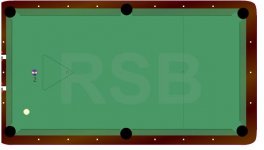Mr. Harriman, I'm well acquainted with your level of excellence, and yes, my high run is only one third of yours, but I disagree with you on both points you make.
In a vacuum, I agree that it's better to create a break ball sooner than later and I also agree that there's nothing conceptually problemmatic with behind-the-rack break shots.
Still, a higher priority than both of these is to try to leave a break shot that gives you a good attack angle into the pack and also a relaistic chance to control the cue ball off of the pack. My concern here is that, in this layout, manufacturing a break ball below the pack will probably leave it below the center of the pack, forcing you to run the cue ball firmly into the third ball in the back row. This is undesirable in terms of both the attack angle and the chance to control the path of the cue ball, explaining why you rarely see a top straight pool player settle for this angle on a break shot.
I guess what I'm saying is that I don't much care for the break shot below if I'm faced with it, and would much prefer ball in hand in the kitchen and a standard break shot, giving me a far greater chance to control both the attack angle into the pack and the path of the cue ball coming off of the rack.
